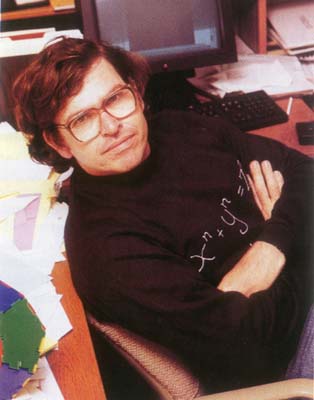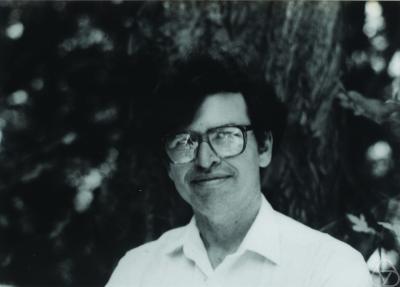<Back to Index>
- Mathematician William Paul Thurston, 1946
PAGE SPONSOR


William Paul Thurston (October 30, 1946 - August 21, 2012) was an American mathematician. He was a pioneer in the field of low - dimensional topology. In 1982, he was awarded the Fields Medal for his contributions to the study of 3-manifolds. He was until his death a professor of mathematics and computer science at Cornell University (since 2003).
His early work, in the early 1970s, was mainly in foliation theory, where he had a dramatic impact. His more significant results include:
- The proof that every Haefliger structure on a manifold can be integrated to a foliation (this implies, in particular that every manifold with zero Euler characteristic admits a foliation of codimension one).
- The construction of a continuous family of smooth, codimension one foliations on the three - sphere whose Godbillon – Vey invariant (after Claude Godbillon and Jacques Vey) takes every real value.
- With John Mather, he gave a proof that the cohomology of the group of homeomorphisms of a manifold is the same whether the group is considered with its discrete topology or its compact - open topology.
In
fact, Thurston resolved so many outstanding problems in foliation
theory in such a short period of time that, according to Thurston, it
led to a kind of exodus from the field, where advisors counseled
students against going into foliation theory because Thurston was
"cleaning out the subject".
His later work, starting around the late 1970s, revealed that hyperbolic geometry played a far more important role in the general theory of 3-manifolds than was previously realized. Prior to Thurston, there were only a handful of known examples of hyperbolic 3-manifolds of finite volume, such as the Seifert – Weber space. The independent and distinct approaches of Robert Riley and Troels Jørgensen in the mid - to - late 1970s showed that such examples were less atypical than previously believed; in particular their work showed that the figure eight knot complement was hyperbolic. This was the first example of a hyperbolic knot.
Inspired by their work, Thurston took a different, more explicit means of exhibiting the hyperbolic structure of the figure eight knot complement. He showed that the figure eight knot complement could be decomposed as the union of two regular ideal hyperbolic tetrahedra whose hyperbolic structures matched up correctly and gave the hyperbolic structure on the figure eight knot complement. By utilizing Haken's normal surface techniques, he classified the incompressible surfaces in the knot complement. Together with his analysis of deformations of hyperbolic structures, he concluded that all but 10 Dehn surgeries on the figure eight knot resulted in irreducible, non - Haken non - Seifert - fibered 3-manifolds. These were the first such examples; previously it had been believed that except for certain Seifert fiber spaces, all irreducible 3-manifolds were Haken. These examples were actually hyperbolic and motivated his next revolutionary theorem.
Thurston proved that in fact most Dehn fillings on a cusped hyperbolic 3-manifold resulted in hyperbolic 3-manifolds. This is his celebrated hyperbolic Dehn surgery theorem.
To complete the picture, Thurston proved a hyperbolization theorem for Haken manifolds. A particularly important corollary is that many knots and links are in fact hyperbolic. Together with his hyperbolic Dehn surgery theorem, this showed that closed hyperbolic 3-manifolds existed in great abundance.
The geometrization theorem has been called Thurston's Monster Theorem, due to the length and difficulty of the proof. Complete proofs were not written up until almost 20 years later. The proof involves a number of deep and original insights which have linked many apparently disparate fields to 3-manifolds.
Thurston was next led to formulate his geometrization conjecture. This gave a conjectural picture of 3-manifolds which indicated that all 3-manifolds admitted a certain kind of geometric decomposition involving eight geometries, now called Thurston model geometries. Hyperbolic geometry is the most prevalent geometry in this picture and also the most complicated. A proof to that conjecture follows from the recent work of Grigori Perelman (2002 – 2003).
In his work on hyperbolic Dehn surgery, Thurston realized that orbifold structures
naturally arose. Such structures had been studied prior to Thurston,
but his work, particularly the next theorem, would bring them to
prominence. In 1981, he announced the orbifold theorem,
an extension of his geometrization theorem to the setting of
3-orbifolds. Two teams of mathematicians around 2000 finally finished
their efforts to write down a complete proof, based mostly on Thurston's
lectures given in the early 1980s in Princeton. His original proof
relied partly on Hamilton's work on the Ricci flow.
Thurston was born in Washington, D.C. to a homemaker and an aeronautical engineer. He received his bachelors degree from New College (now New College of Florida) in 1967. For his undergraduate thesis he developed an intuitionist foundation for topology. Following this, he earned a doctorate in mathematics from the University of California, Berkeley, in 1972. His Ph.D. advisor was Morris W. Hirsch and his dissertation was on Foliations of Three - Manifolds which are Circle Bundles.
After completing his Ph.D., he spent a year at the Institute for Advanced Study, then another year at MIT as Assistant Professor. In 1974, he was appointed Professor of Mathematics at Princeton University. In 1991, he returned to UC - Berkeley as Professor of Mathematics and in 1993 became Director of the Mathematical Sciences Research Institute. In 1996, he moved to University of California, Davis. In 2003, he moved again to become Professor of Mathematics at Cornell University.
His Ph.D. students include Richard Canary, Renaud Dreyer, David Gabai, William Goldman, Benson Farb, Detlef Hardorp, Craig Hodgson, Richard Kenyon, Steven Kerckhoff, Robert Meyerhoff, Yair Minsky, Lee Mosher, Igor Rivin, Oded Schramm, Richard Schwartz, Martin Bridgeman, William Floyd and Jeffrey Weeks. His son, Dylan Thurston, is an assistant professor of mathematics at Barnard College, Columbia University.
Thurston had turned his attention in recent years to mathematical education and bringing mathematics to the general public. He served as mathematics editor for Quantum Magazine, a youth science magazine, and as head of The Geometry Center. As director of Mathematical Sciences Research Institute from 1992 to 1997, he initiated a number of programs designed to increase awareness of mathematics among the public.
In 2005 Thurston won the first AMS Book Prize, for Three - dimensional Geometry and Topology. The prize recognizes an outstanding research book that makes a seminal contribution to the research literature.
In
2012, Thurston was awarded the Leroy P. Steele Prize by the AMS for
seminal contribution to research. The citation described his work as
having "revolutionized 3-manifold theory".
He died on August 21, 2012 in Rochester, New York, of a sinus mucosal melanoma that was diagnosed in 2011.
Thurston and his family had been in the process of moving back to
Davis, CA, where he was to rejoin the mathematics faculty at UC Davis
while his wife completed her veterinary medical degree. Thurston died
before he could make the move to California. He had remained with his
brother George in Rochester, NY, while his family went ahead of him to
California to get settled, waiting for him to gain better physical
strength for making the cross country trip to California to join them.
Bill's health declined rapidly, and the family returned to Rochester to
be with him during his final days.
In Thurston's last days, he sometimes used American Sign Language to
communicate with his children, Liam and Jade. Bill and Julian had spent a
year studying ASL when Jade was an infant, and the family had become
somewhat fluent. He also communicated by writing on one of his many pads
of paper. One of his last written messages was, "Treasure Island," and
this reference remains mysterious to his family.
Thurston had an Erdős number of 2.